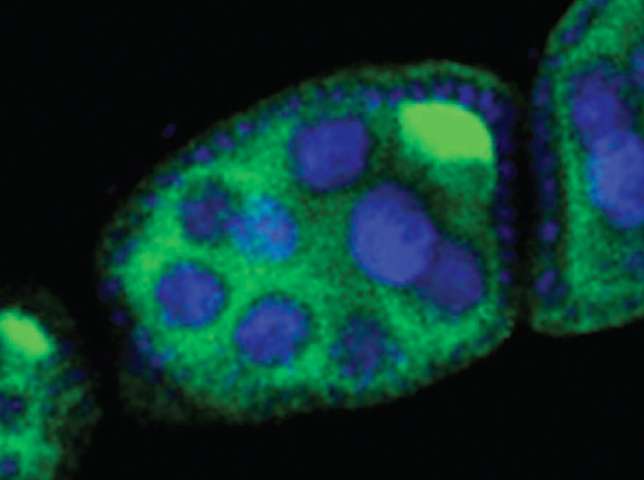|
|
The mighty Panoramix — defender of genomes!
A protein named for a French comic book hero is no joke. It guides cell machinery to silence (turn off) genes and fix havoc caused by organisms that are like bacteria and called transposons.
Humans always need to be defended against parasitic gene parts called transposons. These tiny pieces of DNA disrupt genes by jumping around within our genome and settling on our DNA. Where transposons attach can cause a gene to rewrite its program or even make it inorperable. They can cause so much destruction that cells have dedicated surveillance mechanisms to target and "silence" or turn them off.
To protect future generations against genomic havoc, any defects found in these surveillance mechanisms usually results in the animal's sterility. In animals, the main defense against troublemaking transposons is called the Piwi-interacting RNA pathway.
Now, scientists led by Cold Spring Harbor Laboratory (CSHL) Professor Gregory Hannon, have identified a protein which the Piwi system can use to target transposon locations within the genome without interfering with gene function.
Their work is published in Science.
Hanson is also a Professor and Senior Group Leader at the CRUK Cambridge Institute in the University of Cambridge, United Kingdom.
Hanson and his colleagues have playfully named the protein Panoramix, after a French comic book character who endows others with great power. Panoramix is the venerable druid of the village of Asterix. He is a fountain of knowledge, as well as creator and keeper of secret magic potions.
|
 Panoramix Panoramix |
The Piwi-interacting RNA pathway, which is active in germ cells — those that become sperm and eggs — is a double-tiered defense system. The most direct line of defense finds and chews up RNA copies of transposons, while a second mechanism finds transposons and tags them with chemical signals that instruct the cell to turn them safely off and keep them off. "These two modes of control provide the tightest possible clamp on the system," Hannon adds.
For the current study, Hannon and his colleagues focused on that part of the system that chemically tags transposon on the DNA. This happens just when transposon DNA is copied from its place in the genome into RNA, a process known as transcription.
The challenge for the Piwi system, Hannon explained, is to locate these sequences - which look similar to an organism's own genes - and tag them so they can be recognized to be switched off.
Small RNA molecules called Piwi-interacting RNAs are thought to be capable of finding transposons, but how was unknown. "We wanted to find a link between the very specific transposon pathway and the more general repressing machinery of the cell," explained Hannon.
The scientists had a list of molecules that might play this role, and Yang Yu, a postdoctoral researcher in Hannon's lab at Cold Spring Harbor Laboratory, set out to test each one of them.
The Piwi system is so fast, scientists have found it nearly impossible to follow its components as they silence (turn off) their targets.
So, Yu constructed an artificial Piwi target then stuck different components of the Piwi system to it and monitored what happened next with each new component.
In most situations, cells treated the piece of targeted DNA as one of their own genes. But when Panoramix was attached to an artificial RNA target, cell machinery halted transcription of that DNA. This result suggested that as soon as transcription began, Panoramix recruited the cell's gene silencing machinery to shut off local transcription and mark the intrusive DNA to remain off, even if passed on to future generations.
"This is an incredibly specific phenomenon," Hannon says, noting that Panoramix summons the cell's gene-silencing machinery without affecting the activity of any of the fruit fly's own genes.
Although no Panoramix protein has been found in mammals, it is very likely humans and other animals have a related protein that carries out the same role.
Abstract
The Piwi-interacting RNA (piRNA) pathway is a small RNA–based innate immune system that defends germ cell genomes against transposons. In Drosophila ovaries, the nuclear Piwi protein is required for transcriptional silencing of transposons, though the precise mechanisms by which this occurs are unknown. Here we show that the CG9754 protein is a component of Piwi complexes that functions downstream of Piwi and its binding partner, Asterix, in transcriptional silencing. Enforced tethering of CG9754 to nascent messenger RNA transcripts causes cotranscriptional silencing of the source locus and the deposition of repressive chromatin marks. We have named CG9754 “Panoramix,” and we propose that this protein could act as an adaptor, scaffolding interactions between the piRNA pathway and the general silencing machinery that it recruits to enforce transcriptional repression.
This work was supported by the National Institutes of Health, the American Heart Association, HHMI and Cancer Research United Kingdom.
Return to top of page
|
|
|
Oct 28, 2015 Fetal Timeline Maternal Timeline News News Archive

The piwi-RNA pathway is vital to genome integrity and the wellbeing of immediate offspring
and future generations. This image shows a developing fruit fly egg chamber in which
BLUE-colored 'nurse cells' which support the egg are prominent.
The BRIGHT GREEN area in the upper right portion of the fly egg is a fluorescent tag
signaling the presence of a particular transposon which would induce sterility.
So, the fly
that develops from this egg will be sterile.
Gregory Hannon and team discovered the link between the piwi-RNA pathway, which
finds transposons, and the general cell machinery of a cell that shuts off damaged DNA.
This link protein, they named Panoramix, targets the transposon marking it for "silencing".
Image Credit: Hannon Lab, CSHL
|
|
| |
|




